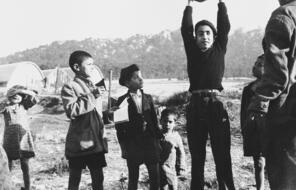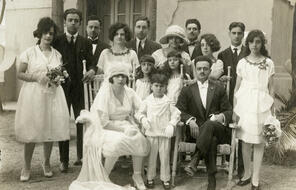Genocide
The term genocide was defined by the Polish Jewish jurist Raphael Lemkin. In 1941, he escaped from eastern Europe and the German occupation that killed most of his family, settled in the United States, and continued his lifelong effort to outlaw the killing of ethnic, religious, cultural, racial, or national groups. 1 In his book Axis Rule in Occupied Europe, published in 1944, Lemkin chose a new term to describe what until then was “a crime without a name.” 2
The term Lemkin coined comes from the Greek word genos, a group defined by kinship, and the Latin cide, to destroy or kill (as in pesticide or homicide). Genocide, then, signifies the destruction of a group of people as a collective with common culture and identity, not just the killing of a lot of people. The Convention on the Prevention and Punishment of the Crime of Genocide was adopted by the United Nations in 1948, just a few years after the horrors the Holocaust. Lemkin was adamant that the term was not simply meant to apply to crimes of the past: it also offered a framework to help prevent future atrocities. He sought a broad definition of genocide that included cultural and economic destruction, but those did not make it into the final draft that was subsequently adopted by the United Nations.
Article 2 of the convention of 1948 defines genocide as “any of the following acts committed with intent to destroy, in whole or in part, a national, ethnical, racial, or religious group, as such”:
(a) Killing members of the group;
(b) Causing serious bodily or mental harm to members of the group;
(c) Deliberately inflicting on the group conditions of life calculated to bring about its physical destruction in whole or in part;
(d) Imposing measures intended to prevent births within the group;
(e) Forcibly transferring children of the group to another group. 3
Connection Questions
- What are the key elements of the UN Genocide Convention (UNGC)? As you reflect on the language in the Genocide Convention, what do you see as the differences between killing individuals, however many, and killing members of a group?
- The Genocide Convention includes the word intent in the definition of genocide. What does that word mean in this context? How do you prove intent? What kinds of evidence would you need? How does the requirement to prove intent help distinguish genocide from other mass atrocities?
- Which articles, if any, of the Genocide Convention seem to you to be most relevant to the treatment of Indigenous Peoples in Canada? Why?
- Canada ratified the United Nations Genocide Convention (UNGC) in 1952 without reservations. But, says David B. MacDonald of the University of Guelph, “When Canada incorporated the UNGC into Canadian law, we did so highly selectively. Portions of the Convention were excluded from the Criminal Code, such that genocide was only defined as Article 2 (a) and (b)." After Canada signed on to the Crimes Against Humanity and War Crimes Act (CAHWCA) in 2000, the full international definition of genocide was brought into domestic criminal law. However, the original law (1952) has not been updated with the full international definition (to include 2 (c), (d), and (e)) even though changes have since been made to that definition of genocide (1952) to expand the protected groups covered by the law. Canada currently seems to have contradicting laws regarding the definition of Genocide in our Criminal Code.
How did the selective incorporation of the Convention impact earlier legal understandings of genocide in Canada? What are some possible contemporary implications to the seemingly contradicting laws? - Read Chapters 6 through 9 of the Facing History & Ourselves resource Totally Unofficial: Raphael Lemkin and the Genocide Convention (2007). In comparison with other international crimes you are familiar with, what is unique about the crime of genocide? Why did the Genocide Convention define genocide as the attempt to destroy a group in whole or in part? What did Raphael Lemkin think about the role of cultural destruction in the crime of genocide?
- 1For more information, see Facing History and Ourselves, Totally Unofficial: Raphael Lemkin and the Genocide Convention (Brookline: Facing History and Ourselves, 2007).
- 2“A crime without a name” was a phrase Winston Churchill used in 1941 to describe the barbarity of the German troops, who executed tens of thousands of civilians, the vast majority of them Jews, as they advanced in eastern Europe. See James T. Fussell, “‘A crime without a name’: Winston Churchill, Raphael Lemkin and the World War II origins of the word ‘genocide,’” Prevent Genocide International website, accessed December 24, 2014.
- 3Convention on the Prevention and Punishment of the Crime of Genocide, Paris, December 9, 1948, accessed October 8, 2014.
How to Cite This Reading
Facing History & Ourselves, "Genocide," last updated November 5, 2019.














